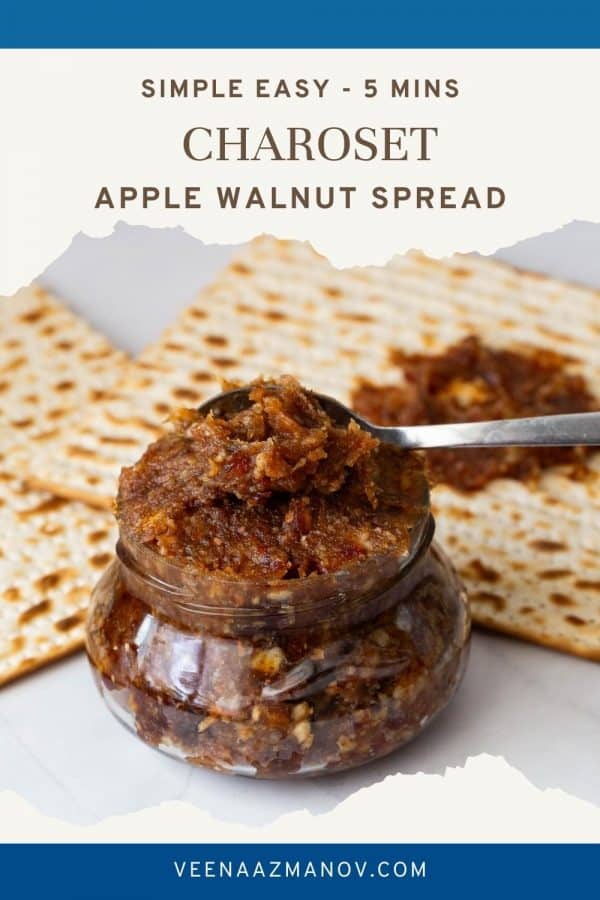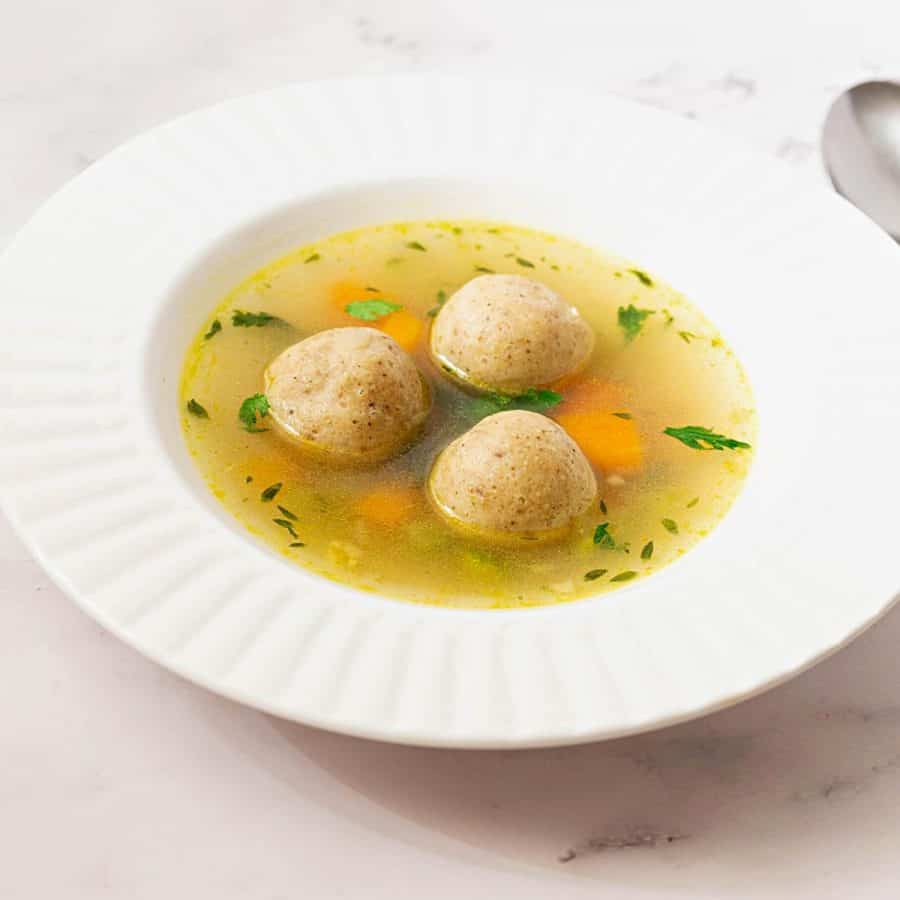Charoset is a sweet, fruit and nut-based paste or relish that is a traditional part of the Passover Seder plate. It is symbolic of the mortar that the Israelites used to build bricks when they were slaves in Egypt. Charoset is typically made from a mixture of chopped or ground fruits, nuts, spices, and sweet wine. The exact ingredients and preparation methods can vary widely based on regional and cultural traditions. Common ingredients include apples, walnuts, almonds, dates, honey or sweet wine, cinnamon, and sometimes other dried fruits or spices. The mixture is often left chunky to represent the mortar, but the texture can vary from smooth to coarse based on personal preference. The significance of charoset lies in its symbolic representation during the Passover Seder, where each element on the Seder plate holds a specific meaning related to the story of the Israelites’ exodus from Egypt:
It symbolizes the mortar the Israelites used to build bricks when they were slaves in Egypt. Its sweet taste reminds us of the hope and sweetness of freedom, even in times of bitterness and hardship. The mixture of fruits and nuts represents the earthiness of the materials used by the Israelites in their labor. It is a mixture, symbolizing the unity of the Jewish people. Its ingredients come together to create something greater than the sum of its parts, reflecting the unity of the Jewish community in times of adversity. The sweetness of this spread contrasts with the bitterness of the maror (bitter herbs) on the Seder plate, symbolizing the hope and joy of redemption that followed the bitterness of slavery.
Overall, the charoset serves as a powerful symbol during the Passover Seder, reminding us of the hardships faced by the Israelites in Egypt and the sweetness of freedom that followed.
Why is this the best recipe
Balance of Flavors: Combining sweet dates, tart apples, and aromatic spices like ginger and cinnamon creates a well-balanced and flavorful charoset. Texture: Pulsing the nuts and dates separately allows you to control the texture, resulting in a chunky yet cohesive mixture perfect for spreading on matzo. Ease of Preparation: This recipe is simple, requiring minimal ingredients and equipment. It can be easily adjusted to suit your preferences. Symbolism: The ingredients used in this recipe are symbolic of the mortar used by the Israelites when they were slaves in Egypt, making it a meaningful addition to the Passover Seder plate.
Ingredients and substitutes
Walnuts and Almonds (or Nuts): These provide the spread’s main texture and nutty flavor. Substitutes could include pecans, hazelnuts, or other nuts of your choice. Dates: Dates add natural sweetness and help bind the mixture together. If you don’t have dates, you could use raisins or prunes as a substitute. Ground Ginger and Cinnamon: These spices add warmth and depth of flavor to the spread. You can adjust the amounts based on your preference. Nutmeg or allspice could be used as substitutes. Sweet Red Wine: The wine adds sweetness and depth of flavor. If you prefer not to use wine, you could use grape or apple juice instead. Grated Apple: The grated apple adds freshness, moisture, and a slightly tart flavor to balance the sweetness. Pear or quince could be used as substitutes.
Step-by-step: Charoset – Walnut apple spread
Nuts – In a food processor, pulse the walnuts and almonds until finely chopped. Remove the nuts from the food processor and set aside. Dates – Pulse the dates in the food processor until they form a paste. Combine – In a large bowl, combine the chopped nuts, date paste, ground ginger, cinnamon, red wine, and grated apple. Mix everything until well combined. Rest – Cover the bowl and refrigerate for at least an hour to allow the flavors to meld. Serve chilled as a symbolic part of your Passover Seder meal.
Tips for Success
Consistency: Depending on your preference, you can make the spread chunky or smooth. Pulse the ingredients in the food processor accordingly. Balance the Flavors: Taste the spread as you go and adjust the sweetness or spiciness to your liking. Add more honey, cinnamon, or ginger as needed. Texture: If the spread is too dry, add a little more wine or honey to moisten it. If it’s too wet, add more nuts or fruit to thicken it. Chill Before Serving: It is best served chilled, so refrigerate it for at least an hour before serving to allow the flavors to meld. Variations: You can experiment with different fruits, nuts, and spices to create your own unique version of this spread. Symbolism: As you prepare the apple walnut spread, reflect on its symbolism and the story of the Israelites’ exodus from Egypt. This can add depth and meaning to your Passover Seder experience.
Creative variations on traditional charoset
Tropical: For a tropical twist, use mango, pineapple, coconut, and macadamia nuts. Add a splash of rum for an extra kick. Sephardic: For a Middle Eastern flair, incorporate flavors like orange zest, pistachios, dates, and a hint of cardamom. Nut-Free: For a nut-free version, use sunflower or pumpkin seeds instead of nuts. You can also add shredded coconut for texture. Spiced: For a spicy kick, add a pinch of cayenne pepper or chili powder. This version pairs well with dark chocolate. Citrus: For a bright, citrusy flavor, use a mix of oranges, grapefruits, and lemons, along with almonds and a touch of orange blossom water. Savory: Roast your apples and add caramelized onions, thyme, and a splash of balsamic vinegar for a savory twist. Apple-Pear: For a more complex flavor, combine equal parts of apples and pears. Add some ginger and a touch of maple syrup for sweetness.
Creative ways to serve charoset
Stuffed Dates: Fill pitted dates with charoset for a sweet and nutty bite-sized treat. Truffles: Roll charoset into small balls and coat them in chopped nuts or cocoa powder for a Passover-friendly dessert. Parfait: Layer charoset with yogurt or whipped cream and top with granola for a delicious and healthy breakfast or dessert. Apple Sandwiches: Slice apples horizontally, remove the core, and fill the center with charoset for a fun and healthy snack. Thumbprint Cookies: Make thumbprint cookies with a mixture of matzo meal and ground nuts, then fill the center with charoset before baking. Mamool cookies – Use charoset as a filling in traditional semolina cookies called mamool. Ice Cream Topping: Warm charoset slightly and drizzle over vanilla ice cream for a decadent Passover dessert.
Gefilte Fish Recipe with Beet HorseradishFlourless Chocolate Cake with Ground Pecans – The Perfect Passover DessertChocolate Walnut Brownies RecipeWalnut Raisin BreadA Rich and Flavorful Carrot Cake with Cream Cheese Frosting
Frequently asked questions
Did you LIKE this recipe? Save it for later. You can find my recipes on Pinterest. Follow me on Facebook, Twitter, and Instagram.Subscribe, and I’ll send you new recipes right to your inbox.
Thank you for sharing - Save for later


















